Effective Caring: Factors, Techniques, and Constraints Report
VerifiedAdded on 2023/01/17
|10
|3187
|71
Report
AI Summary
This report provides a comprehensive overview of effective caring in healthcare. It begins by defining effective caring and its importance in delivering quality patient outcomes. The main body delves into the factors required for a high quality of life, including guidance, superintendence, responsibility, guardianship, trust, looking after, and parenting. It then describes various caring techniques, such as communication, creating trust, gaining compliance, social perception, observation, disengagement, distraction, and physical contact. The report also outlines constraints for positive caring, including cultural and language barriers, resource limitations, and sensory deprivation and disability. Overall, the report emphasizes the multifaceted nature of effective caring and the challenges faced by healthcare professionals in providing optimal patient care.
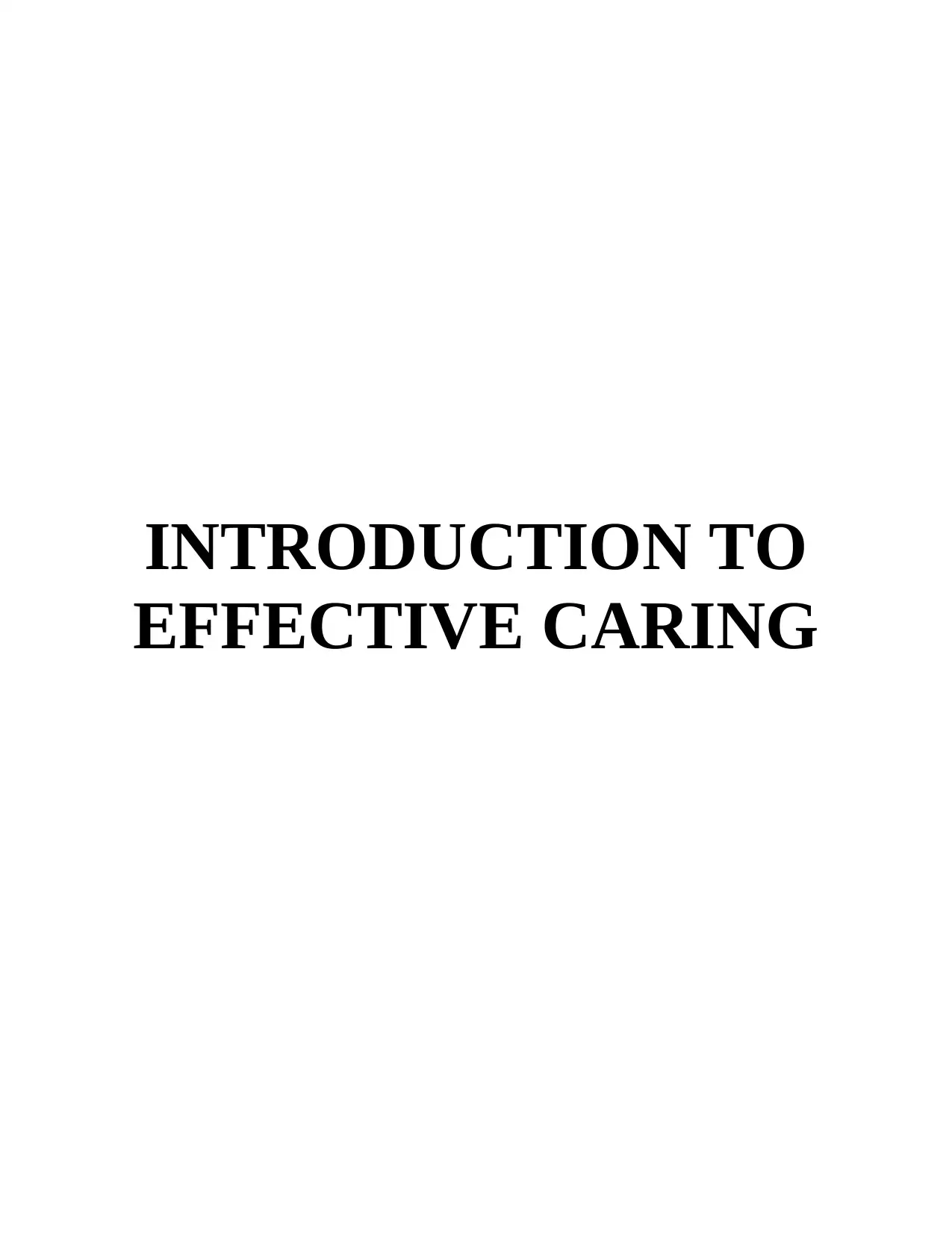
INTRODUCTION TO
EFFECTIVE CARING
EFFECTIVE CARING
Paraphrase This Document
Need a fresh take? Get an instant paraphrase of this document with our AI Paraphraser
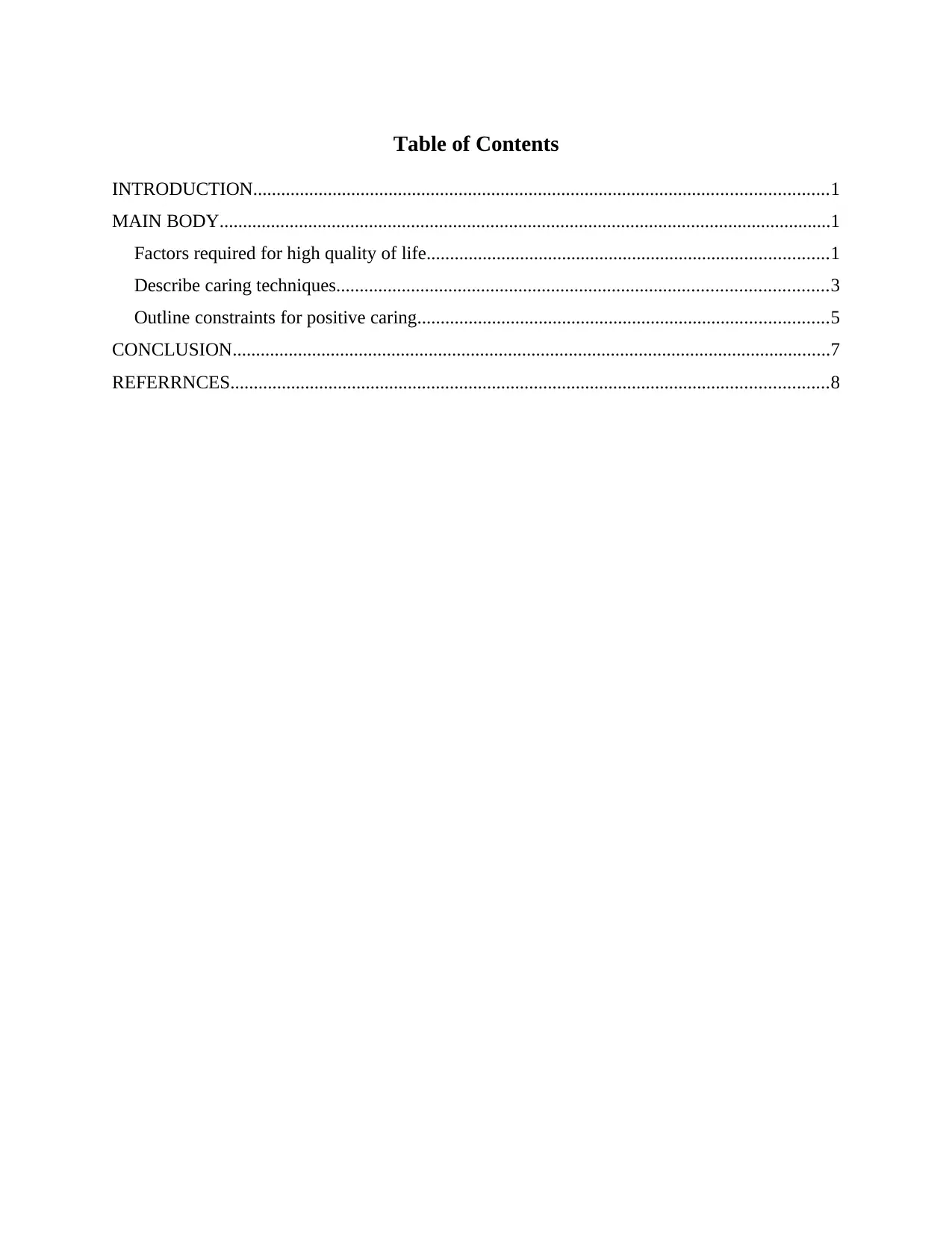
Table of Contents
INTRODUCTION...........................................................................................................................1
MAIN BODY...................................................................................................................................1
Factors required for high quality of life......................................................................................1
Describe caring techniques.........................................................................................................3
Outline constraints for positive caring........................................................................................5
CONCLUSION................................................................................................................................7
REFERRNCES................................................................................................................................8
INTRODUCTION...........................................................................................................................1
MAIN BODY...................................................................................................................................1
Factors required for high quality of life......................................................................................1
Describe caring techniques.........................................................................................................3
Outline constraints for positive caring........................................................................................5
CONCLUSION................................................................................................................................7
REFERRNCES................................................................................................................................8
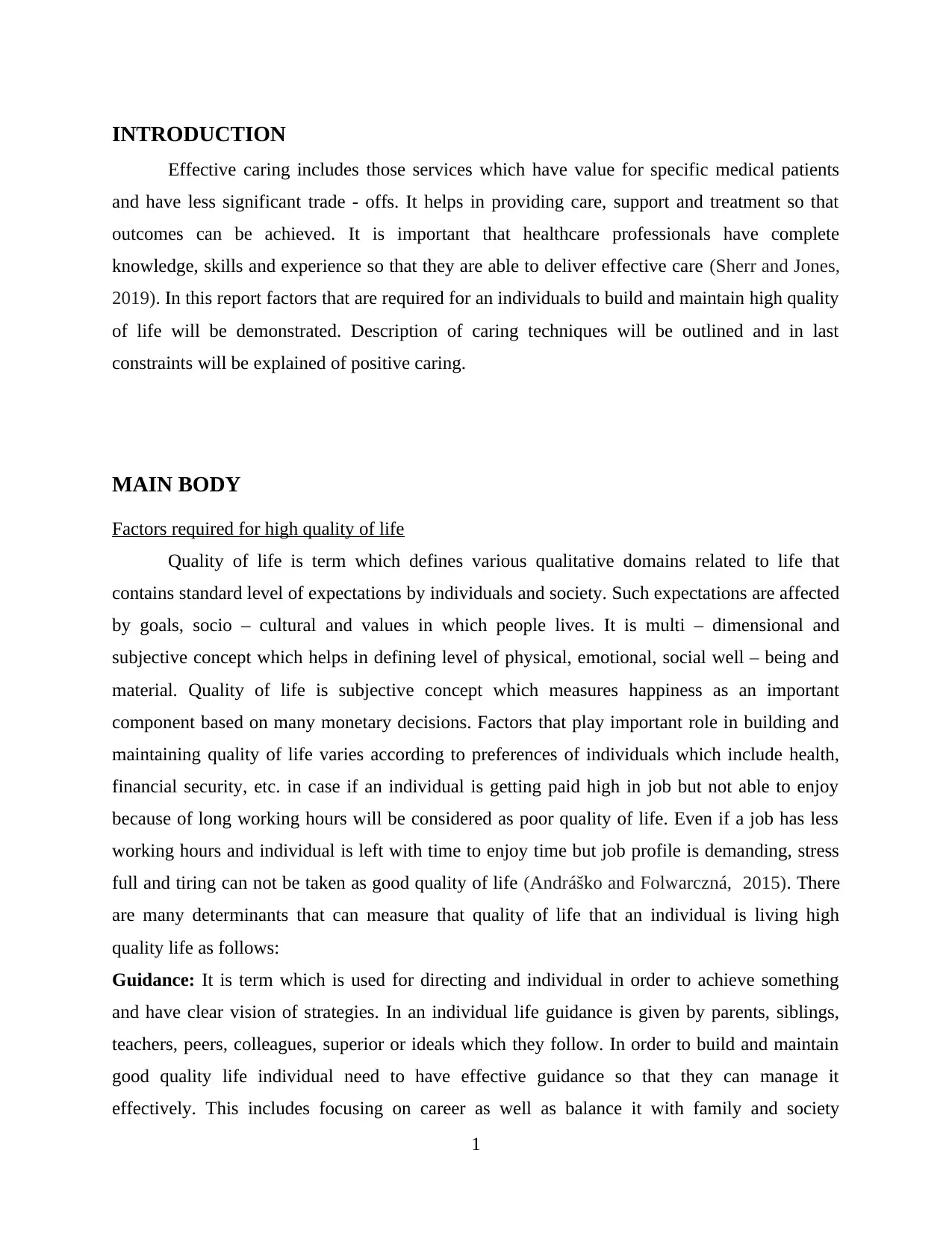
INTRODUCTION
Effective caring includes those services which have value for specific medical patients
and have less significant trade - offs. It helps in providing care, support and treatment so that
outcomes can be achieved. It is important that healthcare professionals have complete
knowledge, skills and experience so that they are able to deliver effective care (Sherr and Jones,
2019). In this report factors that are required for an individuals to build and maintain high quality
of life will be demonstrated. Description of caring techniques will be outlined and in last
constraints will be explained of positive caring.
MAIN BODY
Factors required for high quality of life
Quality of life is term which defines various qualitative domains related to life that
contains standard level of expectations by individuals and society. Such expectations are affected
by goals, socio – cultural and values in which people lives. It is multi – dimensional and
subjective concept which helps in defining level of physical, emotional, social well – being and
material. Quality of life is subjective concept which measures happiness as an important
component based on many monetary decisions. Factors that play important role in building and
maintaining quality of life varies according to preferences of individuals which include health,
financial security, etc. in case if an individual is getting paid high in job but not able to enjoy
because of long working hours will be considered as poor quality of life. Even if a job has less
working hours and individual is left with time to enjoy time but job profile is demanding, stress
full and tiring can not be taken as good quality of life (Andráško and Folwarczná, 2015). There
are many determinants that can measure that quality of life that an individual is living high
quality life as follows:
Guidance: It is term which is used for directing and individual in order to achieve something
and have clear vision of strategies. In an individual life guidance is given by parents, siblings,
teachers, peers, colleagues, superior or ideals which they follow. In order to build and maintain
good quality life individual need to have effective guidance so that they can manage it
effectively. This includes focusing on career as well as balance it with family and society
1
Effective caring includes those services which have value for specific medical patients
and have less significant trade - offs. It helps in providing care, support and treatment so that
outcomes can be achieved. It is important that healthcare professionals have complete
knowledge, skills and experience so that they are able to deliver effective care (Sherr and Jones,
2019). In this report factors that are required for an individuals to build and maintain high quality
of life will be demonstrated. Description of caring techniques will be outlined and in last
constraints will be explained of positive caring.
MAIN BODY
Factors required for high quality of life
Quality of life is term which defines various qualitative domains related to life that
contains standard level of expectations by individuals and society. Such expectations are affected
by goals, socio – cultural and values in which people lives. It is multi – dimensional and
subjective concept which helps in defining level of physical, emotional, social well – being and
material. Quality of life is subjective concept which measures happiness as an important
component based on many monetary decisions. Factors that play important role in building and
maintaining quality of life varies according to preferences of individuals which include health,
financial security, etc. in case if an individual is getting paid high in job but not able to enjoy
because of long working hours will be considered as poor quality of life. Even if a job has less
working hours and individual is left with time to enjoy time but job profile is demanding, stress
full and tiring can not be taken as good quality of life (Andráško and Folwarczná, 2015). There
are many determinants that can measure that quality of life that an individual is living high
quality life as follows:
Guidance: It is term which is used for directing and individual in order to achieve something
and have clear vision of strategies. In an individual life guidance is given by parents, siblings,
teachers, peers, colleagues, superior or ideals which they follow. In order to build and maintain
good quality life individual need to have effective guidance so that they can manage it
effectively. This includes focusing on career as well as balance it with family and society
1
⊘ This is a preview!⊘
Do you want full access?
Subscribe today to unlock all pages.

Trusted by 1+ million students worldwide
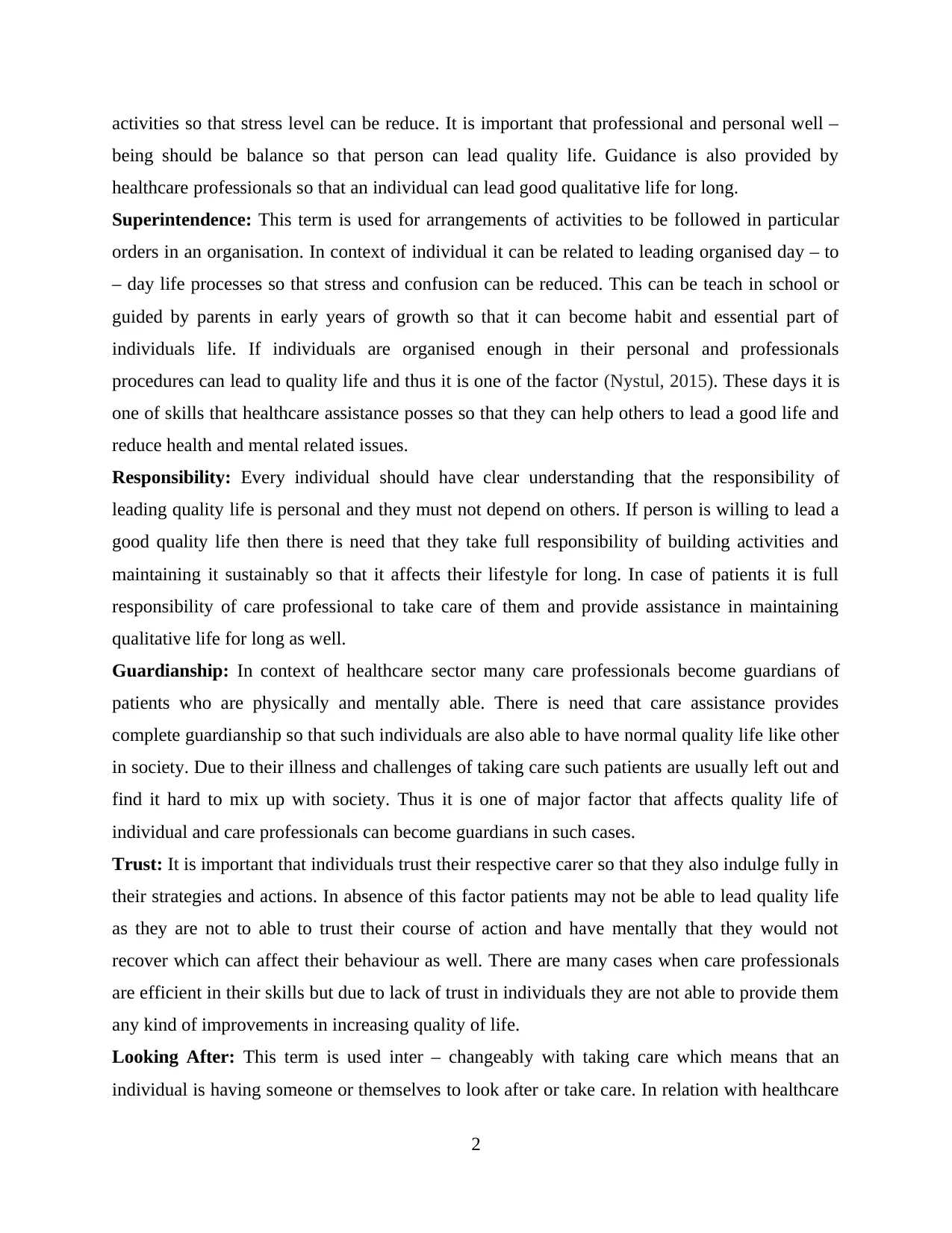
activities so that stress level can be reduce. It is important that professional and personal well –
being should be balance so that person can lead quality life. Guidance is also provided by
healthcare professionals so that an individual can lead good qualitative life for long.
Superintendence: This term is used for arrangements of activities to be followed in particular
orders in an organisation. In context of individual it can be related to leading organised day – to
– day life processes so that stress and confusion can be reduced. This can be teach in school or
guided by parents in early years of growth so that it can become habit and essential part of
individuals life. If individuals are organised enough in their personal and professionals
procedures can lead to quality life and thus it is one of the factor (Nystul, 2015). These days it is
one of skills that healthcare assistance posses so that they can help others to lead a good life and
reduce health and mental related issues.
Responsibility: Every individual should have clear understanding that the responsibility of
leading quality life is personal and they must not depend on others. If person is willing to lead a
good quality life then there is need that they take full responsibility of building activities and
maintaining it sustainably so that it affects their lifestyle for long. In case of patients it is full
responsibility of care professional to take care of them and provide assistance in maintaining
qualitative life for long as well.
Guardianship: In context of healthcare sector many care professionals become guardians of
patients who are physically and mentally able. There is need that care assistance provides
complete guardianship so that such individuals are also able to have normal quality life like other
in society. Due to their illness and challenges of taking care such patients are usually left out and
find it hard to mix up with society. Thus it is one of major factor that affects quality life of
individual and care professionals can become guardians in such cases.
Trust: It is important that individuals trust their respective carer so that they also indulge fully in
their strategies and actions. In absence of this factor patients may not be able to lead quality life
as they are not to able to trust their course of action and have mentally that they would not
recover which can affect their behaviour as well. There are many cases when care professionals
are efficient in their skills but due to lack of trust in individuals they are not able to provide them
any kind of improvements in increasing quality of life.
Looking After: This term is used inter – changeably with taking care which means that an
individual is having someone or themselves to look after or take care. In relation with healthcare
2
being should be balance so that person can lead quality life. Guidance is also provided by
healthcare professionals so that an individual can lead good qualitative life for long.
Superintendence: This term is used for arrangements of activities to be followed in particular
orders in an organisation. In context of individual it can be related to leading organised day – to
– day life processes so that stress and confusion can be reduced. This can be teach in school or
guided by parents in early years of growth so that it can become habit and essential part of
individuals life. If individuals are organised enough in their personal and professionals
procedures can lead to quality life and thus it is one of the factor (Nystul, 2015). These days it is
one of skills that healthcare assistance posses so that they can help others to lead a good life and
reduce health and mental related issues.
Responsibility: Every individual should have clear understanding that the responsibility of
leading quality life is personal and they must not depend on others. If person is willing to lead a
good quality life then there is need that they take full responsibility of building activities and
maintaining it sustainably so that it affects their lifestyle for long. In case of patients it is full
responsibility of care professional to take care of them and provide assistance in maintaining
qualitative life for long as well.
Guardianship: In context of healthcare sector many care professionals become guardians of
patients who are physically and mentally able. There is need that care assistance provides
complete guardianship so that such individuals are also able to have normal quality life like other
in society. Due to their illness and challenges of taking care such patients are usually left out and
find it hard to mix up with society. Thus it is one of major factor that affects quality life of
individual and care professionals can become guardians in such cases.
Trust: It is important that individuals trust their respective carer so that they also indulge fully in
their strategies and actions. In absence of this factor patients may not be able to lead quality life
as they are not to able to trust their course of action and have mentally that they would not
recover which can affect their behaviour as well. There are many cases when care professionals
are efficient in their skills but due to lack of trust in individuals they are not able to provide them
any kind of improvements in increasing quality of life.
Looking After: This term is used inter – changeably with taking care which means that an
individual is having someone or themselves to look after or take care. In relation with healthcare
2
Paraphrase This Document
Need a fresh take? Get an instant paraphrase of this document with our AI Paraphraser
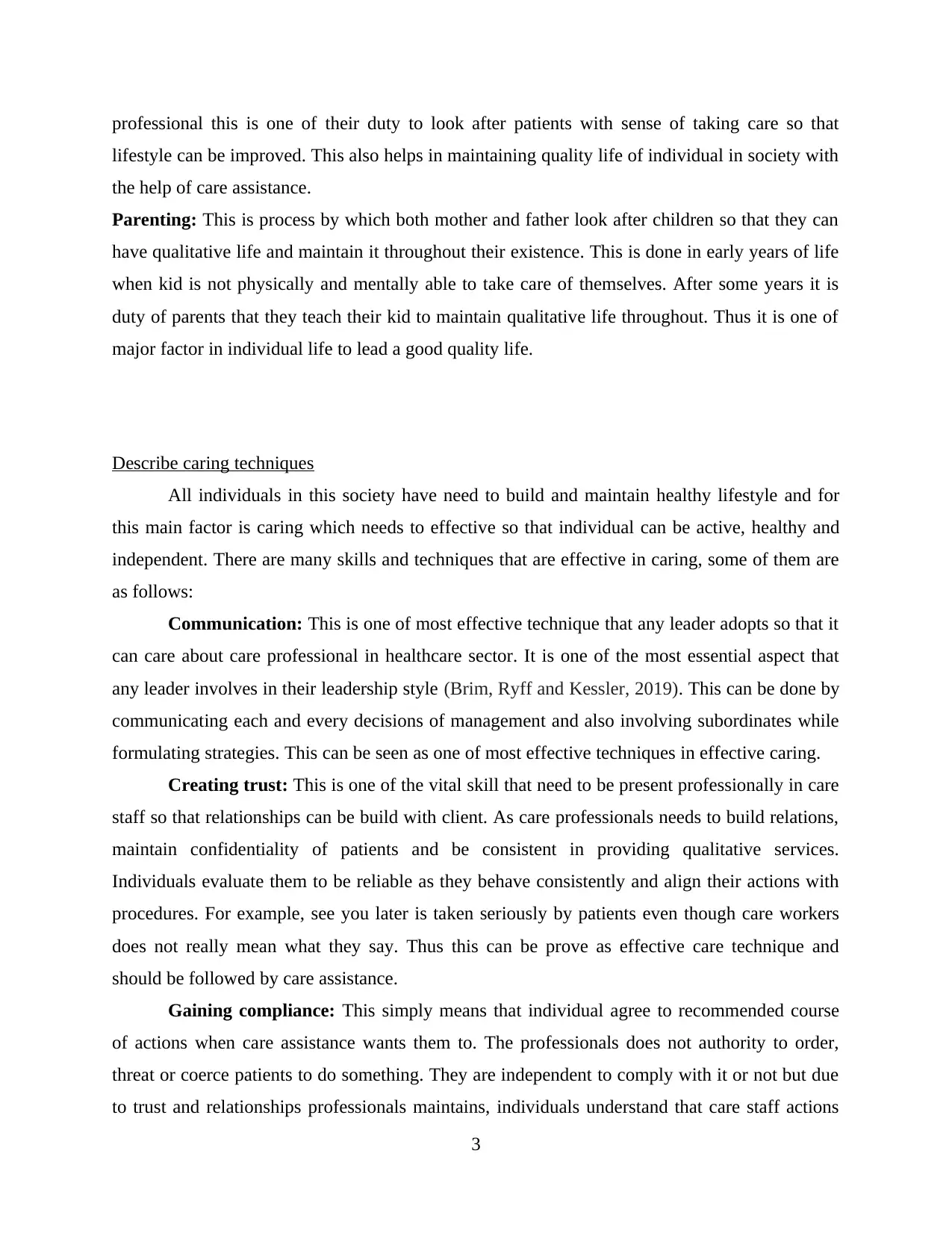
professional this is one of their duty to look after patients with sense of taking care so that
lifestyle can be improved. This also helps in maintaining quality life of individual in society with
the help of care assistance.
Parenting: This is process by which both mother and father look after children so that they can
have qualitative life and maintain it throughout their existence. This is done in early years of life
when kid is not physically and mentally able to take care of themselves. After some years it is
duty of parents that they teach their kid to maintain qualitative life throughout. Thus it is one of
major factor in individual life to lead a good quality life.
Describe caring techniques
All individuals in this society have need to build and maintain healthy lifestyle and for
this main factor is caring which needs to effective so that individual can be active, healthy and
independent. There are many skills and techniques that are effective in caring, some of them are
as follows:
Communication: This is one of most effective technique that any leader adopts so that it
can care about care professional in healthcare sector. It is one of the most essential aspect that
any leader involves in their leadership style (Brim, Ryff and Kessler, 2019). This can be done by
communicating each and every decisions of management and also involving subordinates while
formulating strategies. This can be seen as one of most effective techniques in effective caring.
Creating trust: This is one of the vital skill that need to be present professionally in care
staff so that relationships can be build with client. As care professionals needs to build relations,
maintain confidentiality of patients and be consistent in providing qualitative services.
Individuals evaluate them to be reliable as they behave consistently and align their actions with
procedures. For example, see you later is taken seriously by patients even though care workers
does not really mean what they say. Thus this can be prove as effective care technique and
should be followed by care assistance.
Gaining compliance: This simply means that individual agree to recommended course
of actions when care assistance wants them to. The professionals does not authority to order,
threat or coerce patients to do something. They are independent to comply with it or not but due
to trust and relationships professionals maintains, individuals understand that care staff actions
3
lifestyle can be improved. This also helps in maintaining quality life of individual in society with
the help of care assistance.
Parenting: This is process by which both mother and father look after children so that they can
have qualitative life and maintain it throughout their existence. This is done in early years of life
when kid is not physically and mentally able to take care of themselves. After some years it is
duty of parents that they teach their kid to maintain qualitative life throughout. Thus it is one of
major factor in individual life to lead a good quality life.
Describe caring techniques
All individuals in this society have need to build and maintain healthy lifestyle and for
this main factor is caring which needs to effective so that individual can be active, healthy and
independent. There are many skills and techniques that are effective in caring, some of them are
as follows:
Communication: This is one of most effective technique that any leader adopts so that it
can care about care professional in healthcare sector. It is one of the most essential aspect that
any leader involves in their leadership style (Brim, Ryff and Kessler, 2019). This can be done by
communicating each and every decisions of management and also involving subordinates while
formulating strategies. This can be seen as one of most effective techniques in effective caring.
Creating trust: This is one of the vital skill that need to be present professionally in care
staff so that relationships can be build with client. As care professionals needs to build relations,
maintain confidentiality of patients and be consistent in providing qualitative services.
Individuals evaluate them to be reliable as they behave consistently and align their actions with
procedures. For example, see you later is taken seriously by patients even though care workers
does not really mean what they say. Thus this can be prove as effective care technique and
should be followed by care assistance.
Gaining compliance: This simply means that individual agree to recommended course
of actions when care assistance wants them to. The professionals does not authority to order,
threat or coerce patients to do something. They are independent to comply with it or not but due
to trust and relationships professionals maintains, individuals understand that care staff actions
3
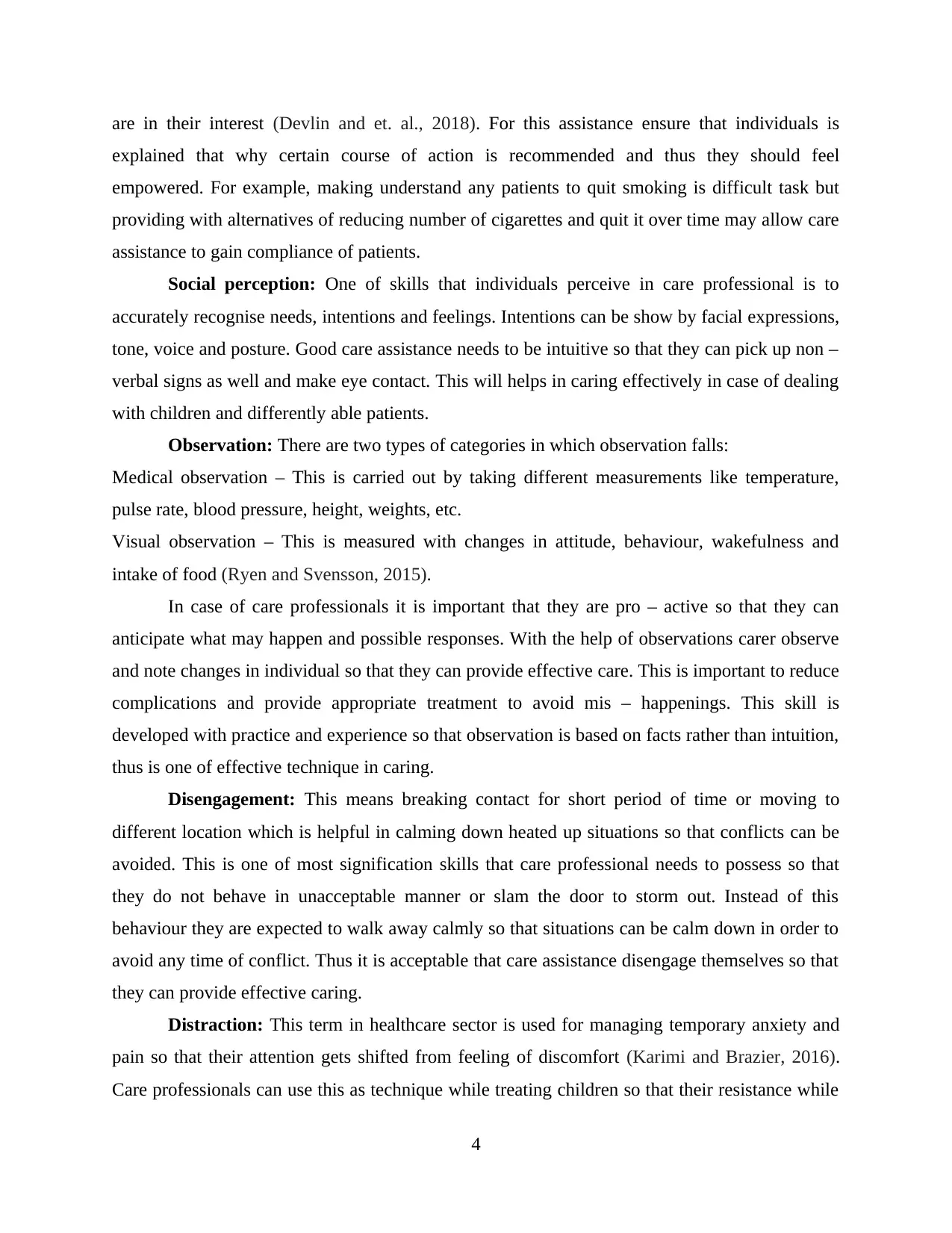
are in their interest (Devlin and et. al., 2018). For this assistance ensure that individuals is
explained that why certain course of action is recommended and thus they should feel
empowered. For example, making understand any patients to quit smoking is difficult task but
providing with alternatives of reducing number of cigarettes and quit it over time may allow care
assistance to gain compliance of patients.
Social perception: One of skills that individuals perceive in care professional is to
accurately recognise needs, intentions and feelings. Intentions can be show by facial expressions,
tone, voice and posture. Good care assistance needs to be intuitive so that they can pick up non –
verbal signs as well and make eye contact. This will helps in caring effectively in case of dealing
with children and differently able patients.
Observation: There are two types of categories in which observation falls:
Medical observation – This is carried out by taking different measurements like temperature,
pulse rate, blood pressure, height, weights, etc.
Visual observation – This is measured with changes in attitude, behaviour, wakefulness and
intake of food (Ryen and Svensson, 2015).
In case of care professionals it is important that they are pro – active so that they can
anticipate what may happen and possible responses. With the help of observations carer observe
and note changes in individual so that they can provide effective care. This is important to reduce
complications and provide appropriate treatment to avoid mis – happenings. This skill is
developed with practice and experience so that observation is based on facts rather than intuition,
thus is one of effective technique in caring.
Disengagement: This means breaking contact for short period of time or moving to
different location which is helpful in calming down heated up situations so that conflicts can be
avoided. This is one of most signification skills that care professional needs to possess so that
they do not behave in unacceptable manner or slam the door to storm out. Instead of this
behaviour they are expected to walk away calmly so that situations can be calm down in order to
avoid any time of conflict. Thus it is acceptable that care assistance disengage themselves so that
they can provide effective caring.
Distraction: This term in healthcare sector is used for managing temporary anxiety and
pain so that their attention gets shifted from feeling of discomfort (Karimi and Brazier, 2016).
Care professionals can use this as technique while treating children so that their resistance while
4
explained that why certain course of action is recommended and thus they should feel
empowered. For example, making understand any patients to quit smoking is difficult task but
providing with alternatives of reducing number of cigarettes and quit it over time may allow care
assistance to gain compliance of patients.
Social perception: One of skills that individuals perceive in care professional is to
accurately recognise needs, intentions and feelings. Intentions can be show by facial expressions,
tone, voice and posture. Good care assistance needs to be intuitive so that they can pick up non –
verbal signs as well and make eye contact. This will helps in caring effectively in case of dealing
with children and differently able patients.
Observation: There are two types of categories in which observation falls:
Medical observation – This is carried out by taking different measurements like temperature,
pulse rate, blood pressure, height, weights, etc.
Visual observation – This is measured with changes in attitude, behaviour, wakefulness and
intake of food (Ryen and Svensson, 2015).
In case of care professionals it is important that they are pro – active so that they can
anticipate what may happen and possible responses. With the help of observations carer observe
and note changes in individual so that they can provide effective care. This is important to reduce
complications and provide appropriate treatment to avoid mis – happenings. This skill is
developed with practice and experience so that observation is based on facts rather than intuition,
thus is one of effective technique in caring.
Disengagement: This means breaking contact for short period of time or moving to
different location which is helpful in calming down heated up situations so that conflicts can be
avoided. This is one of most signification skills that care professional needs to possess so that
they do not behave in unacceptable manner or slam the door to storm out. Instead of this
behaviour they are expected to walk away calmly so that situations can be calm down in order to
avoid any time of conflict. Thus it is acceptable that care assistance disengage themselves so that
they can provide effective caring.
Distraction: This term in healthcare sector is used for managing temporary anxiety and
pain so that their attention gets shifted from feeling of discomfort (Karimi and Brazier, 2016).
Care professionals can use this as technique while treating children so that their resistance while
4
⊘ This is a preview!⊘
Do you want full access?
Subscribe today to unlock all pages.

Trusted by 1+ million students worldwide
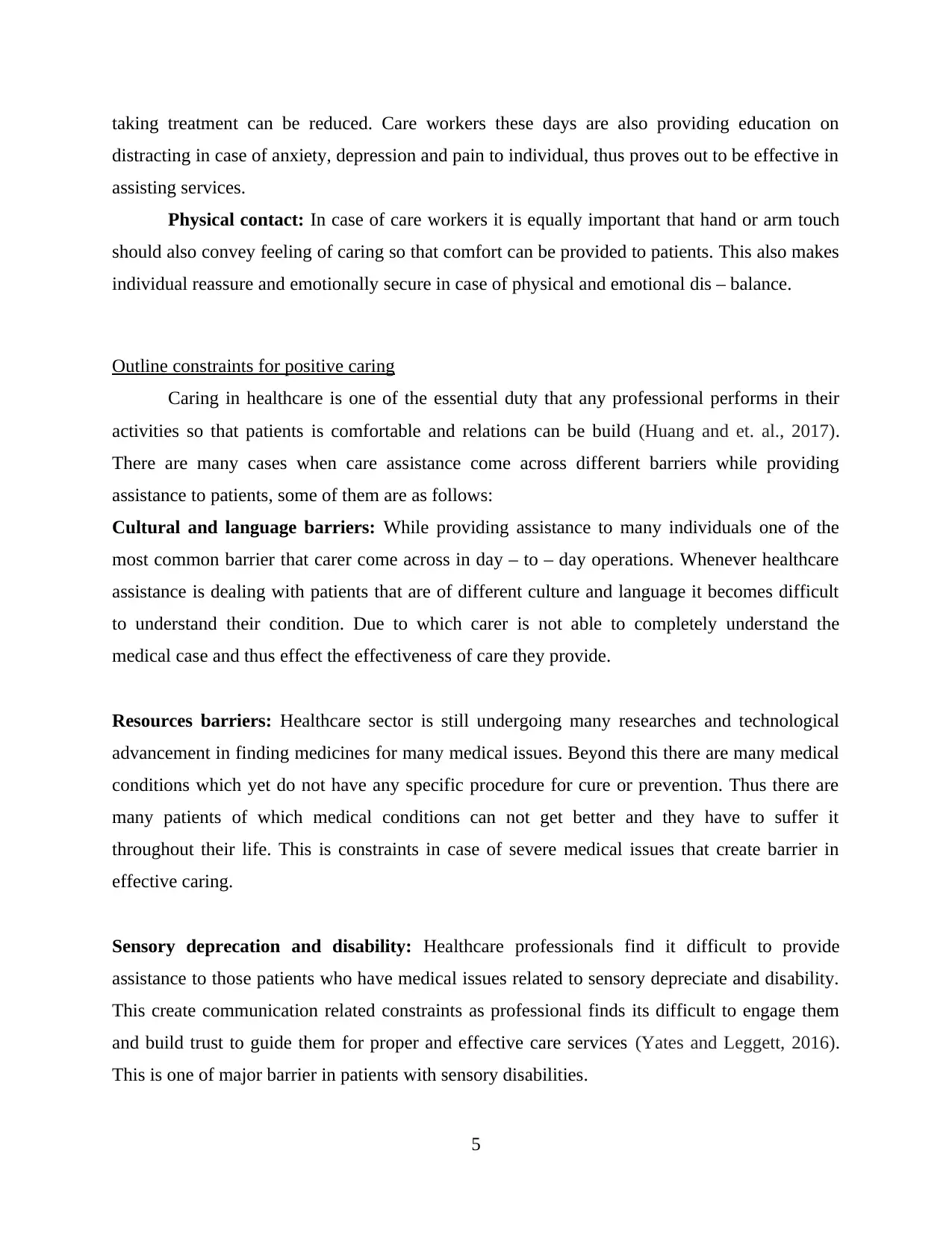
taking treatment can be reduced. Care workers these days are also providing education on
distracting in case of anxiety, depression and pain to individual, thus proves out to be effective in
assisting services.
Physical contact: In case of care workers it is equally important that hand or arm touch
should also convey feeling of caring so that comfort can be provided to patients. This also makes
individual reassure and emotionally secure in case of physical and emotional dis – balance.
Outline constraints for positive caring
Caring in healthcare is one of the essential duty that any professional performs in their
activities so that patients is comfortable and relations can be build (Huang and et. al., 2017).
There are many cases when care assistance come across different barriers while providing
assistance to patients, some of them are as follows:
Cultural and language barriers: While providing assistance to many individuals one of the
most common barrier that carer come across in day – to – day operations. Whenever healthcare
assistance is dealing with patients that are of different culture and language it becomes difficult
to understand their condition. Due to which carer is not able to completely understand the
medical case and thus effect the effectiveness of care they provide.
Resources barriers: Healthcare sector is still undergoing many researches and technological
advancement in finding medicines for many medical issues. Beyond this there are many medical
conditions which yet do not have any specific procedure for cure or prevention. Thus there are
many patients of which medical conditions can not get better and they have to suffer it
throughout their life. This is constraints in case of severe medical issues that create barrier in
effective caring.
Sensory deprecation and disability: Healthcare professionals find it difficult to provide
assistance to those patients who have medical issues related to sensory depreciate and disability.
This create communication related constraints as professional finds its difficult to engage them
and build trust to guide them for proper and effective care services (Yates and Leggett, 2016).
This is one of major barrier in patients with sensory disabilities.
5
distracting in case of anxiety, depression and pain to individual, thus proves out to be effective in
assisting services.
Physical contact: In case of care workers it is equally important that hand or arm touch
should also convey feeling of caring so that comfort can be provided to patients. This also makes
individual reassure and emotionally secure in case of physical and emotional dis – balance.
Outline constraints for positive caring
Caring in healthcare is one of the essential duty that any professional performs in their
activities so that patients is comfortable and relations can be build (Huang and et. al., 2017).
There are many cases when care assistance come across different barriers while providing
assistance to patients, some of them are as follows:
Cultural and language barriers: While providing assistance to many individuals one of the
most common barrier that carer come across in day – to – day operations. Whenever healthcare
assistance is dealing with patients that are of different culture and language it becomes difficult
to understand their condition. Due to which carer is not able to completely understand the
medical case and thus effect the effectiveness of care they provide.
Resources barriers: Healthcare sector is still undergoing many researches and technological
advancement in finding medicines for many medical issues. Beyond this there are many medical
conditions which yet do not have any specific procedure for cure or prevention. Thus there are
many patients of which medical conditions can not get better and they have to suffer it
throughout their life. This is constraints in case of severe medical issues that create barrier in
effective caring.
Sensory deprecation and disability: Healthcare professionals find it difficult to provide
assistance to those patients who have medical issues related to sensory depreciate and disability.
This create communication related constraints as professional finds its difficult to engage them
and build trust to guide them for proper and effective care services (Yates and Leggett, 2016).
This is one of major barrier in patients with sensory disabilities.
5
Paraphrase This Document
Need a fresh take? Get an instant paraphrase of this document with our AI Paraphraser
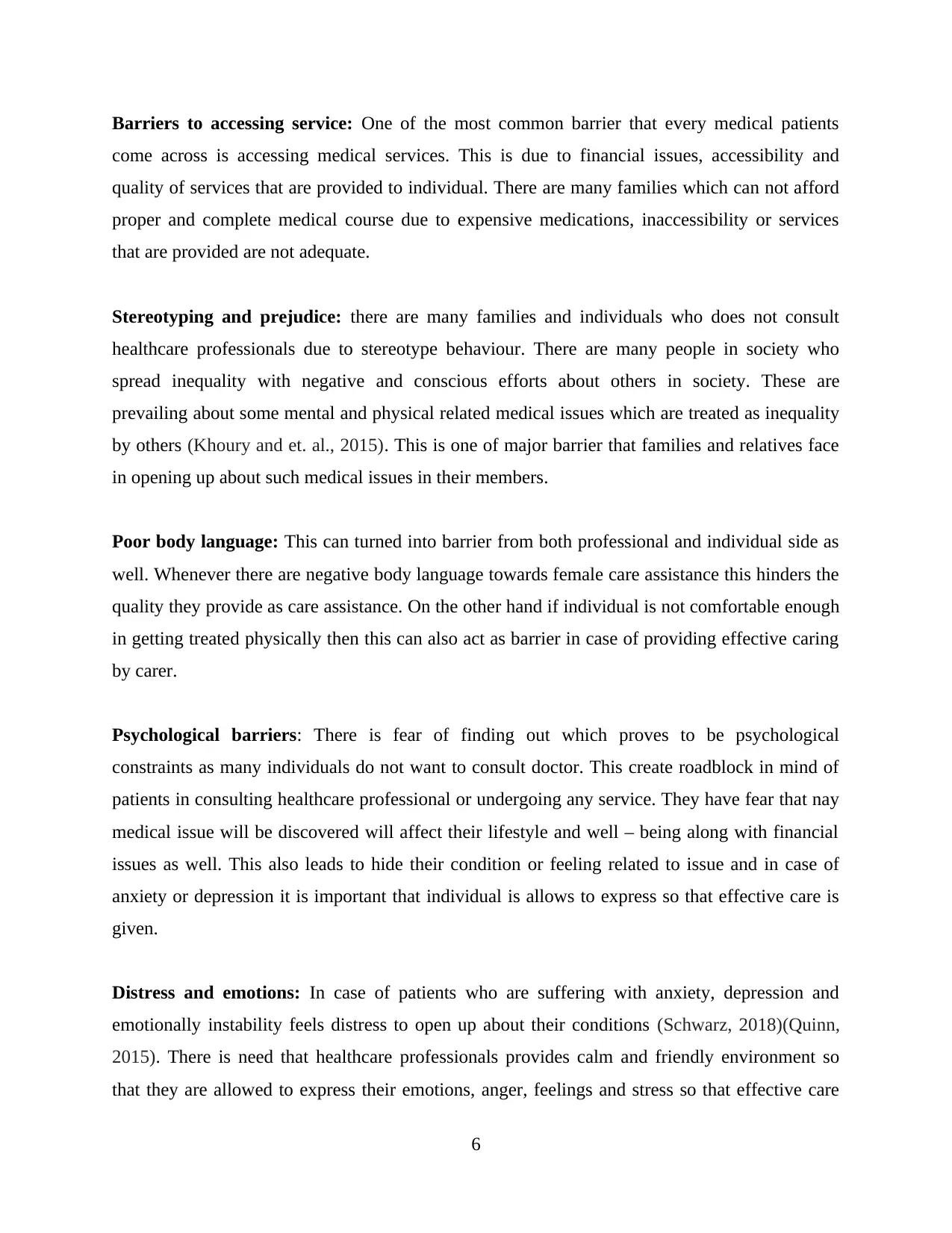
Barriers to accessing service: One of the most common barrier that every medical patients
come across is accessing medical services. This is due to financial issues, accessibility and
quality of services that are provided to individual. There are many families which can not afford
proper and complete medical course due to expensive medications, inaccessibility or services
that are provided are not adequate.
Stereotyping and prejudice: there are many families and individuals who does not consult
healthcare professionals due to stereotype behaviour. There are many people in society who
spread inequality with negative and conscious efforts about others in society. These are
prevailing about some mental and physical related medical issues which are treated as inequality
by others (Khoury and et. al., 2015). This is one of major barrier that families and relatives face
in opening up about such medical issues in their members.
Poor body language: This can turned into barrier from both professional and individual side as
well. Whenever there are negative body language towards female care assistance this hinders the
quality they provide as care assistance. On the other hand if individual is not comfortable enough
in getting treated physically then this can also act as barrier in case of providing effective caring
by carer.
Psychological barriers: There is fear of finding out which proves to be psychological
constraints as many individuals do not want to consult doctor. This create roadblock in mind of
patients in consulting healthcare professional or undergoing any service. They have fear that nay
medical issue will be discovered will affect their lifestyle and well – being along with financial
issues as well. This also leads to hide their condition or feeling related to issue and in case of
anxiety or depression it is important that individual is allows to express so that effective care is
given.
Distress and emotions: In case of patients who are suffering with anxiety, depression and
emotionally instability feels distress to open up about their conditions (Schwarz, 2018)(Quinn,
2015). There is need that healthcare professionals provides calm and friendly environment so
that they are allowed to express their emotions, anger, feelings and stress so that effective care
6
come across is accessing medical services. This is due to financial issues, accessibility and
quality of services that are provided to individual. There are many families which can not afford
proper and complete medical course due to expensive medications, inaccessibility or services
that are provided are not adequate.
Stereotyping and prejudice: there are many families and individuals who does not consult
healthcare professionals due to stereotype behaviour. There are many people in society who
spread inequality with negative and conscious efforts about others in society. These are
prevailing about some mental and physical related medical issues which are treated as inequality
by others (Khoury and et. al., 2015). This is one of major barrier that families and relatives face
in opening up about such medical issues in their members.
Poor body language: This can turned into barrier from both professional and individual side as
well. Whenever there are negative body language towards female care assistance this hinders the
quality they provide as care assistance. On the other hand if individual is not comfortable enough
in getting treated physically then this can also act as barrier in case of providing effective caring
by carer.
Psychological barriers: There is fear of finding out which proves to be psychological
constraints as many individuals do not want to consult doctor. This create roadblock in mind of
patients in consulting healthcare professional or undergoing any service. They have fear that nay
medical issue will be discovered will affect their lifestyle and well – being along with financial
issues as well. This also leads to hide their condition or feeling related to issue and in case of
anxiety or depression it is important that individual is allows to express so that effective care is
given.
Distress and emotions: In case of patients who are suffering with anxiety, depression and
emotionally instability feels distress to open up about their conditions (Schwarz, 2018)(Quinn,
2015). There is need that healthcare professionals provides calm and friendly environment so
that they are allowed to express their emotions, anger, feelings and stress so that effective care
6
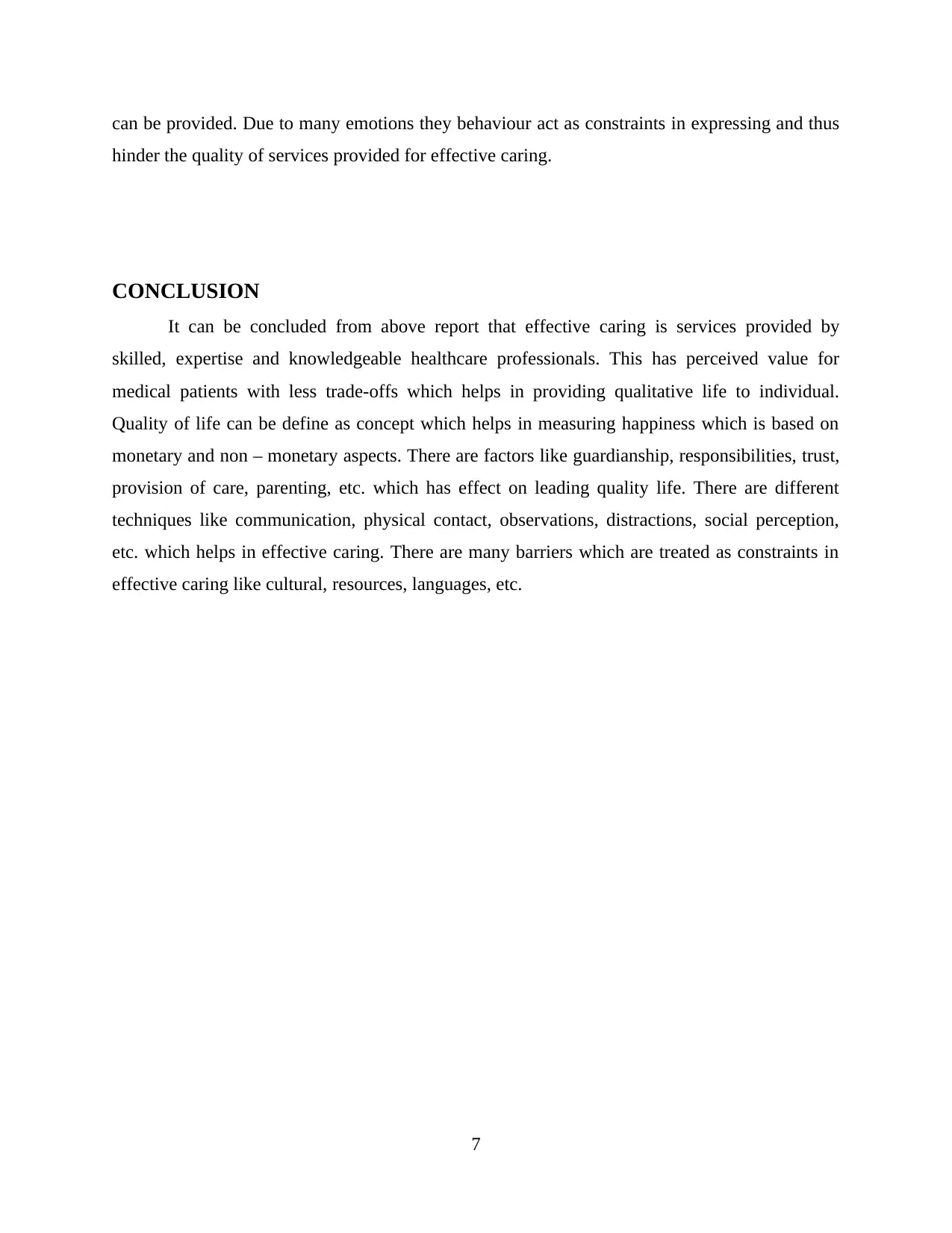
can be provided. Due to many emotions they behaviour act as constraints in expressing and thus
hinder the quality of services provided for effective caring.
CONCLUSION
It can be concluded from above report that effective caring is services provided by
skilled, expertise and knowledgeable healthcare professionals. This has perceived value for
medical patients with less trade-offs which helps in providing qualitative life to individual.
Quality of life can be define as concept which helps in measuring happiness which is based on
monetary and non – monetary aspects. There are factors like guardianship, responsibilities, trust,
provision of care, parenting, etc. which has effect on leading quality life. There are different
techniques like communication, physical contact, observations, distractions, social perception,
etc. which helps in effective caring. There are many barriers which are treated as constraints in
effective caring like cultural, resources, languages, etc.
7
hinder the quality of services provided for effective caring.
CONCLUSION
It can be concluded from above report that effective caring is services provided by
skilled, expertise and knowledgeable healthcare professionals. This has perceived value for
medical patients with less trade-offs which helps in providing qualitative life to individual.
Quality of life can be define as concept which helps in measuring happiness which is based on
monetary and non – monetary aspects. There are factors like guardianship, responsibilities, trust,
provision of care, parenting, etc. which has effect on leading quality life. There are different
techniques like communication, physical contact, observations, distractions, social perception,
etc. which helps in effective caring. There are many barriers which are treated as constraints in
effective caring like cultural, resources, languages, etc.
7
⊘ This is a preview!⊘
Do you want full access?
Subscribe today to unlock all pages.

Trusted by 1+ million students worldwide
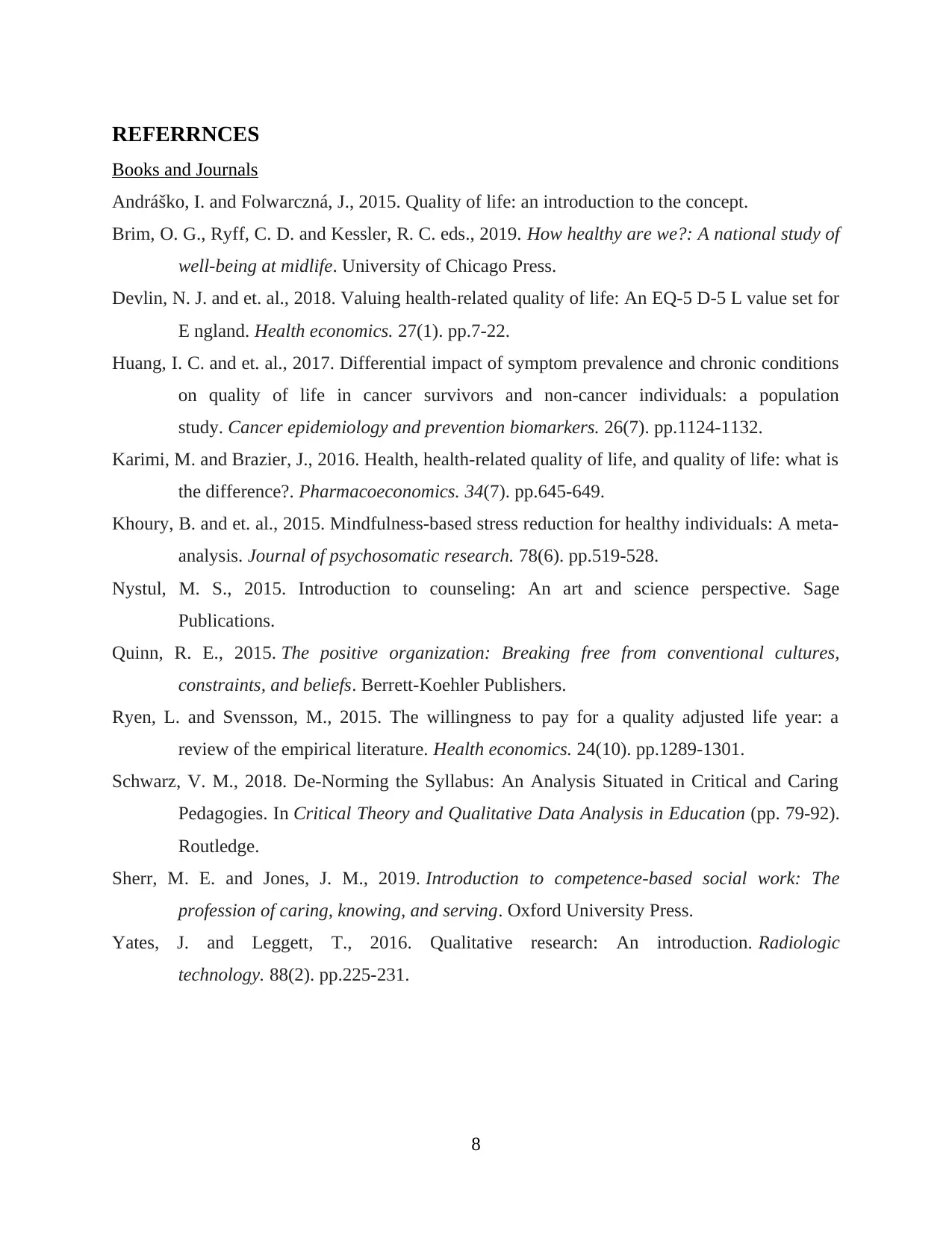
REFERRNCES
Books and Journals
Andráško, I. and Folwarczná, J., 2015. Quality of life: an introduction to the concept.
Brim, O. G., Ryff, C. D. and Kessler, R. C. eds., 2019. How healthy are we?: A national study of
well-being at midlife. University of Chicago Press.
Devlin, N. J. and et. al., 2018. Valuing health‐related quality of life: An EQ‐5 D‐5 L value set for
E ngland. Health economics. 27(1). pp.7-22.
Huang, I. C. and et. al., 2017. Differential impact of symptom prevalence and chronic conditions
on quality of life in cancer survivors and non-cancer individuals: a population
study. Cancer epidemiology and prevention biomarkers. 26(7). pp.1124-1132.
Karimi, M. and Brazier, J., 2016. Health, health-related quality of life, and quality of life: what is
the difference?. Pharmacoeconomics. 34(7). pp.645-649.
Khoury, B. and et. al., 2015. Mindfulness-based stress reduction for healthy individuals: A meta-
analysis. Journal of psychosomatic research. 78(6). pp.519-528.
Nystul, M. S., 2015. Introduction to counseling: An art and science perspective. Sage
Publications.
Quinn, R. E., 2015. The positive organization: Breaking free from conventional cultures,
constraints, and beliefs. Berrett-Koehler Publishers.
Ryen, L. and Svensson, M., 2015. The willingness to pay for a quality adjusted life year: a
review of the empirical literature. Health economics. 24(10). pp.1289-1301.
Schwarz, V. M., 2018. De-Norming the Syllabus: An Analysis Situated in Critical and Caring
Pedagogies. In Critical Theory and Qualitative Data Analysis in Education (pp. 79-92).
Routledge.
Sherr, M. E. and Jones, J. M., 2019. Introduction to competence-based social work: The
profession of caring, knowing, and serving. Oxford University Press.
Yates, J. and Leggett, T., 2016. Qualitative research: An introduction. Radiologic
technology. 88(2). pp.225-231.
8
Books and Journals
Andráško, I. and Folwarczná, J., 2015. Quality of life: an introduction to the concept.
Brim, O. G., Ryff, C. D. and Kessler, R. C. eds., 2019. How healthy are we?: A national study of
well-being at midlife. University of Chicago Press.
Devlin, N. J. and et. al., 2018. Valuing health‐related quality of life: An EQ‐5 D‐5 L value set for
E ngland. Health economics. 27(1). pp.7-22.
Huang, I. C. and et. al., 2017. Differential impact of symptom prevalence and chronic conditions
on quality of life in cancer survivors and non-cancer individuals: a population
study. Cancer epidemiology and prevention biomarkers. 26(7). pp.1124-1132.
Karimi, M. and Brazier, J., 2016. Health, health-related quality of life, and quality of life: what is
the difference?. Pharmacoeconomics. 34(7). pp.645-649.
Khoury, B. and et. al., 2015. Mindfulness-based stress reduction for healthy individuals: A meta-
analysis. Journal of psychosomatic research. 78(6). pp.519-528.
Nystul, M. S., 2015. Introduction to counseling: An art and science perspective. Sage
Publications.
Quinn, R. E., 2015. The positive organization: Breaking free from conventional cultures,
constraints, and beliefs. Berrett-Koehler Publishers.
Ryen, L. and Svensson, M., 2015. The willingness to pay for a quality adjusted life year: a
review of the empirical literature. Health economics. 24(10). pp.1289-1301.
Schwarz, V. M., 2018. De-Norming the Syllabus: An Analysis Situated in Critical and Caring
Pedagogies. In Critical Theory and Qualitative Data Analysis in Education (pp. 79-92).
Routledge.
Sherr, M. E. and Jones, J. M., 2019. Introduction to competence-based social work: The
profession of caring, knowing, and serving. Oxford University Press.
Yates, J. and Leggett, T., 2016. Qualitative research: An introduction. Radiologic
technology. 88(2). pp.225-231.
8
1 out of 10
Related Documents
Your All-in-One AI-Powered Toolkit for Academic Success.
+13062052269
info@desklib.com
Available 24*7 on WhatsApp / Email
![[object Object]](/_next/static/media/star-bottom.7253800d.svg)
Unlock your academic potential
Copyright © 2020–2025 A2Z Services. All Rights Reserved. Developed and managed by ZUCOL.





